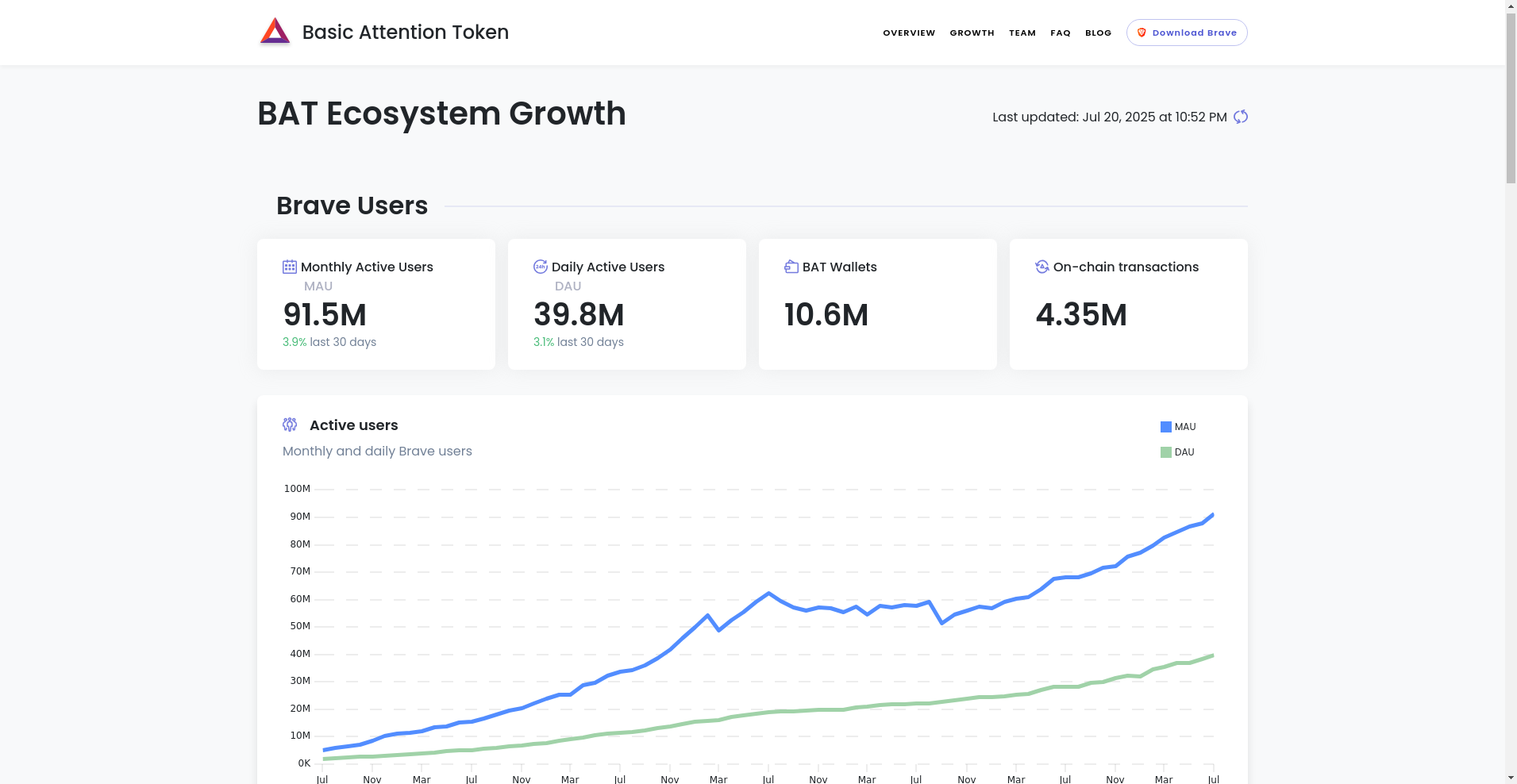Basic Attention Token Review: Scam or Legit Crypto? Uncovering All The Red Flags

Project Overview
The Basic Attention Token (BAT) is marketed as a revolutionary digital advertising token designed to create a more equitable ecosystem. It promises to reward users for their attention, support publishers for their content, and provide advertisers with better targeting and reduced fraud. Powered by the Brave browser, BAT aims to disrupt traditional advertising models by integrating blockchain technology into everyday browsing activities.
However, with ambitious claims and rapid adoption, skepticism is warranted. This investigation dives into the project's foundations, team credibility, security, and real-world activity to determine if BAT is a trustworthy innovation or a high-risk scheme.
Who Is The Team Behind Basic Attention Token?
The backbone of any crypto project is transparency and credibility of its team. BAT is spearheaded by Brendan Eich, a well-known figure in the tech world, creator of JavaScript, and former Mozilla/Firefox executive. His association with prominent institutions adds a veneer of legitimacy. The core team also includes experienced professionals in engineering, security, business, and design, with roles such as CTO, CISO, and VP of Browser Services.
Nevertheless, most team members are publicly known, which is positive. Yet, their past employment at large tech giants like Google, Facebook, and Mozilla raises questions about whether their experience aligns with the project’s claims of decentralization and user privacy. Moreover, some roles are held by individuals whose backgrounds are less transparent or heavily tied to corporate environments, complicating trust.
- Executive team includes Brendan Eich (Mozilla, JavaScript creator)
- Technical leadership features known engineers with experience at major tech companies
- Advisors like Zooko Wilcox (Zcash privacy expert) lend some credibility
Overall, the team has genuine credentials but also significant ties to corporate interests, causing some to question whether their vision for user privacy and decentralization is fully aligned with the project’s marketing rhetoric.
Basic Attention Token Security Audit: A Deep Dive into the Code
For an emerging project, security audits are critical. The available audit data for BAT is limited, with reports from Callisto Network and OpenZeppelin. The Callisto audit notes that the platform is "platform audited," but details are sparse, and no comprehensive bug bounty or code review summary is publicly provided. The OpenZeppelin review highlights standard security practices but does not reveal critical vulnerabilities or complex flaws.
- Platform has undergone basic security reviews, but no detailed third-party audit report is publicly accessible
- Active bug bounty programs suggest ongoing vulnerability hunting, yet no major exploit incidents are reported
- One incident is noted as true, but further transparency is lacking
While these signs are somewhat reassuring, the lack of a transparent, comprehensive security audit raises concerns. Investors should consider the risk that undisclosed vulnerabilities may exist, especially in smart contracts that manage large sums of user funds and tokenomics.
Basic Attention Token Tokenomics: A Fair System or a Trap?
BAT's tokenomics are designed around a fixed supply of 1.5 billion tokens, with over 99% circulating. The distribution includes allocations for team, advisors, ecosystem development, and a User Growth Pool. The whitepaper emphasizes utility within the Brave browser ecosystem, rewarding users and publishers.
- Total Supply: 1.5 billion BAT
- Circulating Supply: Over 1.49 billion BAT (>99%)
- Team/Advisors: Fairly small, generally around 20-25% of total supply, with vesting periods
- User Growth Pool / UGP: Significant allocation (~10%), used to incentivize user engagement and publisher onboarding
- Potential Risks: Concentration risk in the hands of early holders; high supply relative to utility-based demand may lead to inflationary pressures or dumps
A high supply combined with a centralized distribution could lead to selling pressure, especially if the team or early investors decide to liquidate. The token's market value is largely driven by adoption and platform activity, which remains dependent on user growth and corporate partnerships.
Is Basic Attention Token a Ghost Town? Checking for Real Activity
The ecosystem claims impressive growth: over 91 million monthly active users (MAU), nearly 2 million verified publishers, and hundreds of millions of BAT displaced in rewards. These figures are sourced from the project's own summaries and third-party indicators. Yet, much of this activity is inflated by marketing claims or estimated engagement metrics rather than transparent, verifiable data.
Real-world activity appears concentrated around the Brave browser, which is indeed growing, but questions remain whether the platform sustains consistent user engagement or relies heavily on promotions and incentivization. The use of the UGP (User Growth Pool) to distribute BAT also raises concerns about artificially boosting activity metrics at the expense of genuine utility.
Moreover, the ongoing third-party audits and security checks seem superficial, and widespread adoption beyond initial circles seems limited. Ultimately, the progress appears promising on paper but needs independent verification to confirm true ecosystem health.
What Basic Attention Token's Legal Documents Are Hiding
- The Terms of Service include clauses on arbitration, termination, and liability waivers that heavily favor the project’s operators.
- Provisions permit the company to modify terms unilaterally, and disputes are typically subject to arbitration in the Cayman Islands, potentially complicating legal recourse for users.
- The Terms disclaim warranties and liability, including for lost funds, exploits, or platform failures, which could leave users unprotected in case of malpractice or security breaches.
- Significant restrictions on legal actions, including binding arbitration and waivers of class actions, limit individual users' ability to seek redress.
This legal framework indicates a high degree of control by the project operators and could pose risks for investors and users in cases of disputes or fraud.
Final Verdict: Should You Risk Investing in Basic Attention Token?
While BAT presents itself as an innovative project combining blockchain, privacy, and advertising, critical red flags remain. The team is partially credible but heavily tied to the mainstream tech industry, reducing decentralization claims. The limited, opaque security audits and the potential for platform misuse threaten user funds and data. Despite massive reported growth figures, independent verification is scarce, and the ecosystem’s true health remains questionable.
- Positive Points:
- Founders have impressive backgrounds (e.g., Brendan Eich).
- Brave browser has grown significantly, with actual user base metrics.
- Active bug bounty programs exist, indicating ongoing security efforts.
- Major Red Flags:
- Limited, non-transparent security audits raise security concerns.
- High token supply and potential for centralization, risking dump or inflation.
- Potential ecosystem manipulation via reward pools and incentivization schemes.
- Genuine community engagement and long-term utility are yet to be convincingly proven.
In conclusion, investors should approach Basic Attention Token with caution, conducting comprehensive due diligence and considering the significant red flags before engaging or investing. Its promise of revolutionizing advertising remains unconfirmed by independent audits and long-term adoption metrics, making it a high-risk asset for now.

Olivia Lewis
Sociotechnical Systems Analyst
I analyze the intersection of social networks and blockchain systems. I use data to expose how scammers manipulate communities with bots, FUD, and engineered hype.
Similar Projects
-
DRAGON ON TRON
DRAGON ON TRON ($DGTRON) Review: Risks and Legitimacy Explored
-
Blobo ($BLOBO)
Comprehensive Review of Blobo ($BLOBO): Is This Meme Coin a Scam or Legitimate Project? | Crypto Scam Checker
-
Billiards Hub
Review of Billiards Hub: Is this Blockchain Gaming Project a Scam or Legit?
-
GYEN
GYEN Review: Scam or Legit Stablecoin? In-Depth Analysis
-
Pixel Puffin ($PIXP)
Comprehensive Review of Pixel Puffin ($PIXP): Crypto Scam Checker & Project Analysis